By Danny Carvalho
Question - “I have a group of 10-year-olds who are pretty skillful, but their defending technique is very poor. I really need to start from scratch. Do you have any good 1v1 defending drills and then some drills to train the cover defender?””
I hear you, my friend. And I am sure that after this article you will never have to go through this pain again!
One of my favorite works is the individual defensive skills and tactics. Most people think it’s too hard and challenging but it can be quite simple and effective.
To start with, I’ll give you something that you and the players will never forget: THE 4 “S” of defense!
1- Slow down;
2- Side on;
3- Sit down;
4- Step in
Once the defender closed down and got close to the opponent, that’s when they need to (1) SLOW DOWN. Stay on the opponent’s way, “be an obstacle” but don’t dive in yet! Once they slowed down, comes the moment to force the opponent to their weak foot, to a teammates’ direction or away from our goal by staying (2) SIDE ON. Next step is to (3) SIT DOWN. That means lowering gravity center by bending their knees a bit. This will make it easier for the defender to change direction or sprint after the attacker in case of a big touch. Last step is to (4) STEP IN when the attacker gives the chance. The triggers to step in are:
• Ball far from front foot
• Foot off the ground / off balance
• Attacker dribbles backwards
Follow below a simple, effective and fun activity to develop this on your players.
ACTIVITY 1
Setup:
In doubles, one ball each double, 20 to 30 yards apart and facing each other. Players on the right will start with the ball.
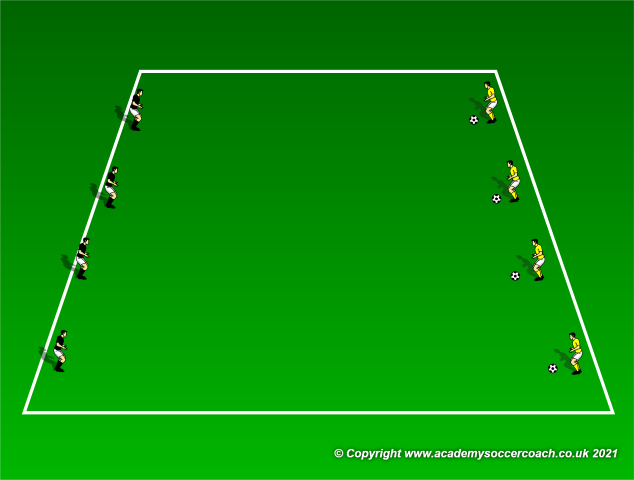
Execution:
Yellow players will send the ball to the black players and sprint towards them to close them down. Once they get to an optimal distance, they are going to implement the 4S as the black players dribble against them. As this happens, the yellow players will jockey back to their lines while marking the black players. At this point of the activity, yellow players will not try to win the ball. We are only working on the technique.
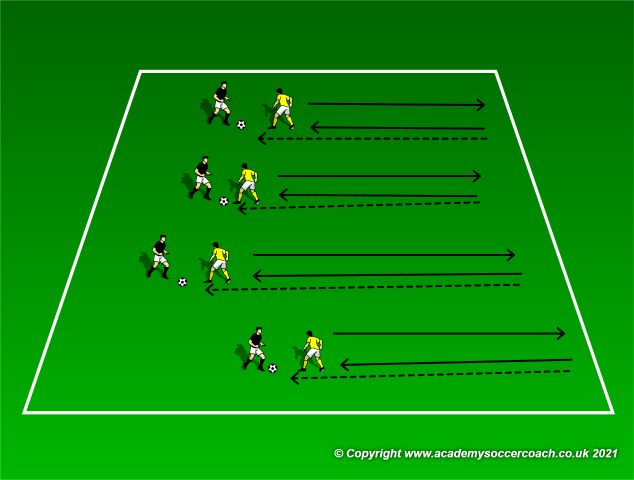
After three rounds, swap players so everyone gets a good number of repetitions no matter what position they usually play.
Next step is to make this a little bit more game realistic. So now, defenders will actually try to win the ball. So, we are going to make it be a 1v1 this time. Set up some 1v1 corridors on the same structure with end scoring zones. The scoring rules is:
• 1 point every time you win the ball
• -1 point every time you get scored on
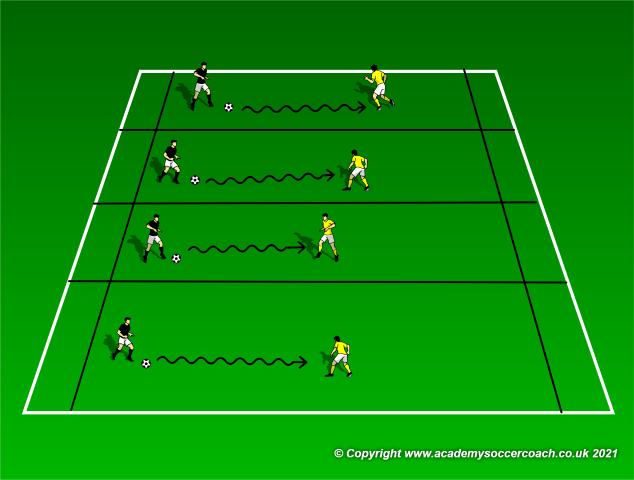
To make it more challenging and motivating, call the corridors division 1, 2, 3, 4… Play for 1 to 2minutes rounds. Winner goes up a division, loser goes down a division. Winner on the 1st division stays there, loser on the bottom division stays there.
COACHING POINTS:
1. Always emphasize the 4S
2. Game principles: 1st goal of a defender is to avoid getting scored on. 2nd goal is to stop progression. 3rd is to win the ball.
3. Attention to the triggers to step in
VARIATIONS
- Split the corridor into two halves. Defender can go into opponent’s zone but can only win the ball when attacker storms into his half.
- 2v1
ACTIVITY 2
Here goes a defending 1v1 that I love and it’s full of content and valuable defensive information.
Setup:
Set up a grid approximately 20 yards long x 15 yards wide. The defender will start on one end and the attacker on another. On the defender’s end you will set up three gates. Follow below the diagram for better understanding.
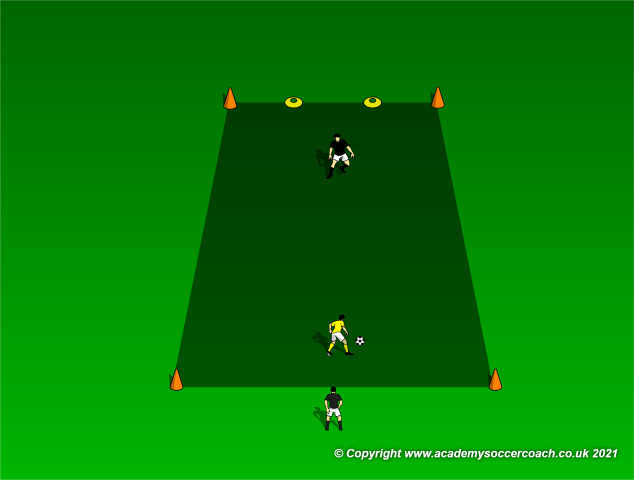
Execution:
Attacking player starts with the ball and their goal is to break through de defender’s end. The defender on the other hand must stop the attacker from scoring. If the defender wins the ball, they can 1- pass to the coach/player on the other end or 2- dribble past the opponent’s end line.
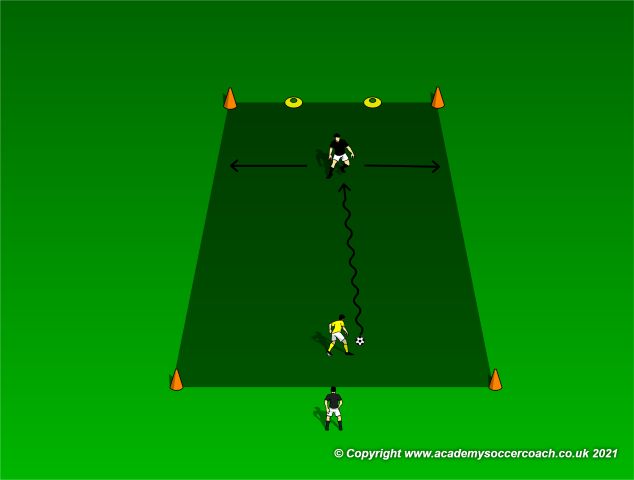
Pointing rules are (always for the defending player):
• Attacker dribbles past side gates (between orange cone-yellow disc cone) = -1 point
• Attacker dribbles past center gate = - 3 points
• Attacker doesn’t score = 1 point
• Defender wins possession = 2 points
• Defender passes to coach/player or dribbles past end line = 3 points
If possible, set up 3 or 4 grids and call them Division 1, 2, 3 and 4. Play each round (call it SEASONS to create the competitive atmosphere) for about 3-4 minutes. Have them keep their scores and at the end of the season the top ranked player moves up a division and the bottom ranked player moves down a division.
The grids can vary on size according to the division to make it easier or harder to defend as shown on the diagram below.
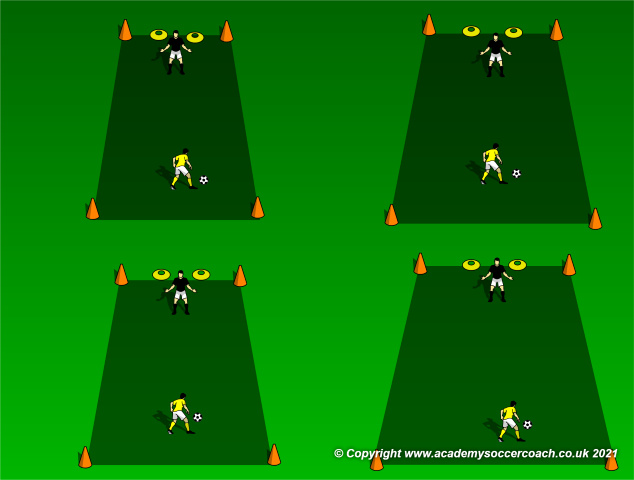
COACHING POINTS:
- Force the attacker to the sidelines and backwards whenever possible
- Protect the center as much as possible
- As soon as you win the ball make a decision whether to pass or to dribble
VARIATIONS
- Both ends with the gates set
- 2v1s
By Danny Carvalho, DOC at Corinthians Campinas Youth Club, Brasil


